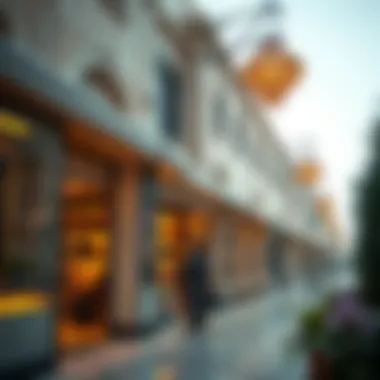A Guide to Abaya Shops in Dubai: Styles and Trends


Intro
Dubai has become a bustling hub for fashion, particularly in the realm of traditional garments such as the abaya. As a symbol of cultural identity and elegance, the abaya shops in this city offer much more than just clothing. They serve as a melding point between age-old traditions and contemporary styles, reflecting the dynamic nature of Fashion in the UAE. In the following sections, we will explore various factors that contribute to the allure of abaya shopping in Dubai. From current market conditions and emerging trends to insights about popular boutiques, this guide is crafted for those keen on understanding the fabric of this vibrant fashion scene.
Market Trends and Analysis
Current Market Conditions
The abaya market in Dubai is thriving, fueled by a combination of local demand and a steady influx of tourists. Numerous shops span across the city, from luxurious boutiques to smaller, family-owned establishments. This diversity caters to different tastes and budgets. Moreover, traditional designs are undergoing transformation with the incorporation of modern fabrics, intricate embroidery, and unique cuts. The fusion of traditional elements with contemporary aesthetics allows shoppers to express individuality while honoring cultural heritage.
Recent studies indicate that as of 2023, the growth rate of the abaya market has been at a notable pace, with an estimated market size reaching approximately $1 billion. The rising appreciation for high-quality craftsmanship and the customization of designs have played pivotal roles in bolstering this market.
Future Predictions and Growth Areas
Looking ahead, several growth areas can be identified. Firstly, the rise in online shopping presents an opportunity for abaya brands to expand their reach beyond the local market. With online platforms gaining momentum, boutique owners are increasingly investing in e-commerce, offering customized shopping experiences.
Furthermore, sustainability has emerged as a crucial focus. Consumers are increasingly seeking eco-friendly options, prompting brands to innovate with sustainable materials. As the global emphasize on ethical fashion grows, those who adapt to these preferences are likely to thrive.
"The future of abaya shopping in Dubai isn’t just about tradition; it’s about reinvention."
The Cultural Significance of the Abaya
The abaya is more than just a piece of clothing; it embodies deep cultural roots and reflects values intrinsic to Emirati society. Understanding its significance is crucial for anyone looking to navigate Dubai’s vibrant fashion scene. The abaya is often perceived as a symbol of modesty and dignity, particularly among women. It serves as a bridge between past traditions and contemporary expressions of identity.
Historical Context
Historically, the abaya can trace its origins back centuries, evolving alongside the cultural narratives of the region. Early variations of the garment primarily served practical purposes, providing comfort and protection from the harsh desert climate. With the steady growth of trade and cultural exchanges, the abaya began to reflect the influences of neighboring regions as well. In the past, colors and designs were simple, often dictated by the fabrics that were available locally.
As time moved on, especially through the late 20th century and into the 21st, the abaya began to adapt and change. The garment was not just a reflection of practicality; it became a canvas for self-expression. Traditional designs started to incorporate intricate embroidery and embellishments influenced by Bedouin artistry, thus marking a significant shift in its role within Emirati culture. This blend of practicality and artistry is significant, showcasing how the abaya stands as a testament to both heritage and evolution.
Modern Interpretations
Today, the abaya exists at the crossroads of tradition and modernity. Designers have taken the classic silhouette and transformed it into a multifaceted garment that resonates with contemporary fashion trends. It's not uncommon to see abayas adorned with modern textiles and bold patterns, blending descriptions of culture with current aesthetics. What was once a garment strictly reserved for formal occasions has now seeped into everyday wear, reflecting personal style while still observing cultural protocols.
Furthermore, international fashion influences have sparked a wave of creativity within the abaya market. High-end designers and local artisans alike are reimagining this traditional attire, integrating elements such as asymmetrical cuts and versatile styles that appeal to a broader audience.
In light of these innovations, many women see the abaya not just as a necessity but as a vital part of their self-identity. Through unique designs, the abaya allows wearers to articulate their personalities, fostering a sense of belonging while also celebrating individuality.
The transformation of the abaya transcends clothing; it embodies the spirit of Emirati women, symbolizing freedom, elegance, and a connection to cultural heritage.
Aspects such as color, fabric choice, and embellishments reflect personal choice and societal trends. This significant evolution of the abaya continues to affirm its relevance in contemporary cultures, proving that even traditional garments can thrive amidst global fashion currents.
Overview of the Abaya Market in Dubai
The abaya market in Dubai stands as a vibrant and significant sector that not only addresses fashion but also encapsulates cultural identity and heritage. In a city where tradition meets modernity, the demand for abayas showcases a unique blend of preservation and innovation. Understanding this market lays the groundwork for those wishing to navigate the rich offerings of Dubai, offering insights into its subtleties and fluctuations.
Not merely a garment, the abaya embodies deep-seated cultural meanings and connection for many women in the region. With the growing influx of expatriates and tourists, the market is evolving into a melting pot of design influences. This dynamic environment creates a precious opportunity for both local designers and international brands to expand their reach.
Market Trends and Dynamics
The abaya market in Dubai is characterized by rapid transformations driven by consumer demand and global fashion trends. One trend that has marked recent years is the incorporation of luxurious fabrics and intricate designs, reflecting a shift towards more personal expression rather than uniformity. Here are some notable dynamics in play:
- Luxury and Customization: Consumers are increasingly gravitating toward high-end options that allow for customization. This may involve bespoke designs that cater to individual tastes, demonstrating a desire for exclusivity and personal touch.
- Digital Influence: With many abaya brands adopting e-commerce, the reach of these products extends well beyond the local market. Online shopping has become a vital trend, allowing international customers to participate in the local fashion scene conveniently.
- Seasonal Collections: Influenced by fashion cycles, many shops now launch seasonal collections that reflect current trends, moving away from static offerings. Collaborations with designers to create exclusive lines are also becoming common.
These trends illustrate how fluid the market can be, adapting to new influences while respecting tradition.
Consumer Preferences
Understanding the consumers in the abaya market is crucial for any aspiring retailer or designer. Today's shoppers are highly diverse, and their buying habits reflect a mix between cultural respect and contemporary aesthetics.
- Ethical Considerations: Many buyers are becoming aware of the impact their purchases have. They tend to favor brands that consume sustainable materials and practice ethical labor standards. This has led to an increase in demand for eco-friendly abayas.Reputable shops are now promoting their commitment to quality and transparency.
- Style Versatility: Shoppers look for abayas that they can wear on multiple occasions — from formal events to casual outings. This versatility pushes designers to create pieces that balance elegance with functionality. Bright colors and striking patterns are also gaining traction, breaking the typical monochrome mold.
- Social Media Trends: Social media platforms play a significant role in shaping consumer tastes. Influencers often highlight their favorite abayas, prompting shoppers to follow related hashtags and engage with brands directly online.
- Cultural Representation: There's a growing preference for designs that reflect cultural significance and heritage, often leading consumers to seek local brands that emphasize traditional craftsmanship. Authentic storytelling has also become a significant selling point.
The confluence of these preferences shapes the landscape of abaya shopping in Dubai, revealing a market rich with opportunity for innovation and growth.
Types of Abayas


Understanding the different types of abayas is essential for anyone looking to explore the vibrant abaya market in Dubai. This diversity represents not just fashion choices, but also cultural expressions. When choosing an abaya, consider factors such as personal style, occasion, and cultural significance. From traditional to contemporary, the options are plenty and reflect the rich heritage of the region while catering to modern aesthetics.
Traditional Designs
Traditional abayas are often characterized by their classic silhouettes, typically crafted from flowing fabrics that exude elegance. These designs tend to emphasize modesty while allowing for personal expression. One common style is the black abaya, which remains a staple in many wardrobes. These pieces often feature intricate embroidery or embellishments that highlight regional craftsmanship.
In the traditional sense, the abaya serves as more than just clothing; it is a symbol of cultural identity. The patterns and embroidery styles may vary by region, showcasing a rich tapestry of local influences. When it comes to buying a traditional abaya, it's important to look for quality fabrics and craftsmanship. Natural fibers like silk and cotton are preferable not only for comfort but also for durability.
"Investing in a good quality traditional abaya pays off in both style and longevity."
Contemporary Styles
As fashion evolves, so too does the abaya. Contemporary styles have emerged that blend traditional elements with modern trends. Bright colors, unique cuts, and fashionable prints are now prevalent in today’s offerings. Those looking for a bit of flair might choose an abaya featuring asymmetrical hems or layered fabrics. Many contemporary designers also experiment with daring silhouette variations and striking patterns.
Shopping for contemporary abayas can be a thrilling experience in Dubai’s chic boutiques. These shops often update their collections frequently, reflecting the latest fashion trends and seasonal styles. Many contemporary abayas allow for ease of movement, making them suitable for various occasions, from formal events to casual outings.
Custom-Made Options
For those who find off-the-rack options lacking, custom-made abayas are a wise bet. These can be tailored to fit individual preferences, both in terms of design and fit. Working with a skilled tailor allows you to choose everything from the fabric to the specific embellishments, ensuring that the final piece is uniquely yours. Customization is particularly beneficial for special occasions like weddings or significant family events where a traditional touch is desired.
When considering a custom process, start with a clear vision of the style you desire. Bring reference images and fabric samples to discuss with the tailor. Keep in mind that while this option may take more time and investment, the outcome is often a one-of-a-kind piece that offers personal significance.
In sum, the various types of abayas available in Dubai reflect a dynamic interplay between tradition and contemporary fashion. Each style offers something unique, catering to different tastes and needs. Understanding these options enchances one's experience of abaya shopping, aligning personal style with cultural appreciation.
Notable Abaya Shops in Dubai
When it comes to exploring abaya shopping in Dubai, notable abaya shops play a vital role in shaping the overall experience of both locals and visitors. These shops serve as cultural hubs, showcasing the diversity in styles, designs, and craftsmanship that characterize the abaya. By focusing on the prominent players in this market, shoppers can make informed decisions and appreciate the rich history intertwining tradition with modern aesthetics.
Flagship Boutiques
Flagship boutiques are the hallmark of high-quality abaya shopping in Dubai. They often embody the essence of luxury and innovation, providing an array of designs that cater to different tastes and preferences. Shops like Elie Saab and Reem Acra are not just places to buy clothing; they are destinations that reflect the latest trends in abaya fashion. With extravagant displays and personalized services, these boutiques create an environment that elevates the shopping experience.
Inside flagship boutiques, expert stylists guide customers through selections, ensuring that every shopper finds something that reflects their unique identity. The use of premium fabrics, delicate embroidery, and intricate embellishments sets these shops apart. Buyers are not just purchasing a piece of clothing; they are acquiring a work of art.
Hidden Gems
While the flagship boutiques are undoubtedly impressive, there are also countless hidden gems in Dubai that offer unique abayas at more accessible prices. Shops like Al Aneeq and Oud Al Maktoum may not be as widely known, but they are treasure troves for anyone looking to discover authentic designs that capture the local spirit. These boutiques often focus on traditional craftsmanship, using locally sourced materials to create garments that tell a story.
Shopping at these hidden gems provides a more intimate experience. The staff tends to invest considerable time in each customer, offering personalized advice that larger stores might overlook. Many of these boutiques also carry exclusive lines that can’t be found elsewhere, making for an exciting shopping adventure. If you’re after something truly unique, exploring these lesser-known shops is essential.
Online Shopping Options
In the digital age, online shopping has become an integral component of the abaya market in Dubai. Websites like Namshi and Mango offer customers a wide range of choices, from classic to contemporary styles, all from the comfort of their homes. This convenience facilitates access to various designs and brands that may not have a physical presence in Dubai.
When shopping online, customers can browse a larger selection and often find competitive pricing. With the ability to compare styles easily, shoppers can ensure they're getting the best value without the hustle and bustle of a physical store. However, online shopping does come with considerations: it's vital to check sizing charts and return policies, as each brand may have unique manufacturing standards.
Overall, the notable abaya shops in Dubai, whether they are flagship boutiques, hidden gems, or online stores, enrich the shopping landscape. Each offers a unique angle on abaya fashion, providing various experiences tailored to the needs of different shoppers. By considering these options, you're better equipped to navigate the vibrant world of abaya shopping in Dubai.
Shopping Experience in Abaya Stores
When stepping into the enchanting world of abaya shopping in Dubai, the experience is much more than just picking out a garment. It's about immersing oneself in a vibrant culture, where fashion intertwines seamlessly with tradition. The shopping experience in abaya stores is vital because it influences not only what you choose to wear but also how you connect with the rich heritage that these garments represent. Understanding the nuances of the shopping experience can elevate your selection process and deepen your appreciation for the artistry behind each piece.
In-Store Experience
The in-store experience at abaya shops offers a delightful mix of sensory engagement and personal touch. As you step through the doors, often adorned in intricate decor and rich fabrics, you're welcomed into a space where every detail speaks to a history of craftsmanship. Many shops scent the air with traditional incense or perhaps the aroma of exotic teas, creating an inviting environment.
While browsing, it is common to find collections displayed with great care. Soft lighting often highlights the shimmering details of high-quality fabrics and elegant beadwork. As you flick through rows of exquisite abayas, the shop staff typically play a pivotal role. Knowledgeable and often warmly engaging, they guide you through the options while offering customization to both size and design—a valuable aspect, especially for expatriates or new residents seeking a piece that resonates with their individual style.
"Shopping for an abaya is not just a transaction; it's about finding a piece that feels like a second skin, reflecting your unique persona."
Furthermore, many boutiques incorporate colorful displays featuring accessories—such as hijabs and bags—that complement the abayas. This curated aesthetic not only provides style inspiration but also enhances your overall shopping journey.
Personal Shopping Services
The personal shopping services offered by many abaya stores in Dubai add a layer of convenience and luxury to your experience. Typically, these services cater to all kinds of shoppers, whether you're well-versed in abaya fashion or a first-time buyer. A personal shopping assistant can be invaluable in navigating choices based on body type, color preferences, and upcoming events.


For instance, if you’re preparing for a formal occasion or a cultural event, a personal shopper can help select designs that best showcase your style while adhering to local customs. Many stores also provide private fitting rooms, where experienced staff ensure that the fit of the abayas complements your figure while maintaining comfort. This level of attentiveness often leads to better fitted garments, arguably one of the most important aspects when you intend to wear something regularly.
Additionally, these services may extend beyond the shopping floor. Some shops offer follow-up services, assisting with care tips or alterations after your purchase. Therefore, investing time in a personal shopping experience not only makes your journey smoother but also enriches the connection with the local fashion scene, enhancing your appreciation for Dubai’s cultural diversity.
Ending
In sum, the shopping experience in abaya stores in Dubai is an intricate tapestry woven with cultural significance and personal interaction. From the enticing in-store atmosphere to the bespoke services offered, every aspect serves to create a memorable journey for each shopper. This deepens one’s connection not just to the garment itself but to the culture that surrounds it, ensuring that your choice of abaya is not just a trend but a testament to a timeless tradition.
Pricing Insights
Understanding pricing in the abaya market is key for anyone looking to invest in this traditional yet evolving garment. Prices vary widely based on so many factors, from the quality of fabric to brand reputation. Moreover, as customs evolve and new trends emerge, the landscape of abaya pricing in Dubai reflects these dynamics deeply.
When considering a purchase, shoppers should think not just about their budget but also about the value they are getting in return. Whether one is after an everyday abaya or something more luxurious for a special occasion, getting to grips with pricing helps consumers make informed decisions. This section will break down what drives prices and how best to navigate them.
Factors Affecting Abaya Prices
A multitude of factors contribute to the cost of abayas, each influencing the final price differently:
- Material Quality: The fabric used is paramount. Abayas made from high-grade silk or intricate lace often come with a heftier price tag than those constructed from simpler materials like cotton or polyester.
- Design Complexity: Hand-embroidered or embellished designs usualy cost more due to the skilled labor involved in their creation.
- Brand Reputation: Well-known designers or boutiques often price their abayas at a premium, reflecting brand prestige and craftsmanship.
- Market Dynamics: Seasonal trends, such as during Ramadan or Eid, can affect availability and pricing—prices may increase when demand is high.
- Customization: Custom-made abayas that cater specifically to personal taste will inherently demand higher prices, given their individuality.
These factors make it clear why some abayas can be found at a low cost while others reach luxury-tier pricing.
Comparative Pricing
When venturing into the abaya market, comparative pricing becomes an essential tool for savvy shoppers:
- High-End Boutiques vs. Local Markets: High-end boutiques in areas like The Dubai Mall often showcase designer abayas with price tags from AED 1,500 to AED 5,000. In contrast, local markets may offer simpler abayas starting around AED 100.
- Online Versus Brick-and-Mortar Stores: Online platforms like Souq.com or Namshi provide competitive prices and the option to compare various shops easily. Physical stores might have limited selection but sometimes hold exclusive items unavailable online.
- Sales and Discounts: Notably, shopping during sale seasons can make a significant difference. For instance, during Dubai Shopping Festival, shoppers can find substantial markdowns—some discounts may reach up to 50% off from retail prices.
To put things into perspective, a shopper can find the same style abaya tagged between AED 200 and AED 4,000—fluctuating based on all factors previously discussed.
"Understanding pricing helps you not only save money but invest wisely in a piece that resonates with your personal style and cultural appreciation."
By taking time to research and compare, one can navigate the intricate world of abaya pricing without getting lost in the fray.
Sustainable Practices in Abaya Production
Sustainability has become a pivotal aspect of the fashion industry, and the abaya market in Dubai is no exception. With growing awareness about environmental and social impacts, many abaya producers are embedding sustainable practices into their production processes. By focusing on ethical sourcing of materials and supporting local artisans, retailers not only cater to a sophisticated consumer base but also ensure the longevity of their craft. This section elucidates why these sustainable practices are essential today.
Ethical Sourcing of Materials
Ethical sourcing of materials refers to acquiring fabrics and other components in a manner that is both environmentally friendly and socially responsible. In the context of abayas, this means using materials that have minimal negative impact on the planet while also supporting fair labor practices.
Many boutiques in Dubai now opt for organic cotton, sustainable silk, and even recycled materials. This shift is noteworthy as it not only reduces the carbon footprint associated with textile manufacturing but also resonates with consumers who are increasingly conscious of the origins of their clothing. Moreover, by being more selective about their suppliers, abaya retailers create a market for environmentally friendly products, fostering a growing segment of eco-friendly fashion.
This practice is not just good for the earth; it's appealing to the modern consumer. Shoppers today want clothing that aligns with their values. By marketing abayas made from sustainable materials, stores can attract an eco-conscious clientele that prioritizes ethical consumption. It’s a win-win as customers get stylish pieces of clothing while playing their part in sustaining the environment.
Supporting Local Artisans
Support for local artisans within the abaya production process plays a crucial role in sustaining traditional craftsmanship. In many cases, these artisans are the backbone of the fashion industry, keeping alive the age-old techniques passed down through generations. By sourcing work from local creators, shops not only promote traditional artistry but also help stimulate the local economy.
Emphasizing local production often results in unique, customizable pieces that may not be available in mass-produced markets. Customers can enjoy bespoke abayas that reflect personal style instead of wearing the same design as countless others.
“Supporting local artisans contributes to the preservation of cultural identity and fosters a sense of pride in the community.”
The relationship established between retailers and artisans in Dubai is beneficial to both parties. Artisans gain fair compensation and exposure for their work, while stores bolster their brand integrity by aligning with local communities. This symbiotic relationship fosters growth and innovation within the industry, ensuring that the heritage of abaya-making continues while adapting to contemporary tastes.
In summary, the sustainable practices in abaya production, especially concerning ethical sourcing of materials and supporting local artisans, offer a pathway to enrich both the environment and the cultural fabric of Dubai. By honoring tradition and championing new values, abaya shops can thrive while making lasting contributions to society.
Care and Maintenance of Abayas
When it comes to owning an abaya, understanding its care and maintenance is vital. Not only does this ensure the longevity of the garment, but it also preserves the beauty and elegance that these pieces encapsulate. Given that abayas can vary significantly in fabric and design, tailored care practices can make a world of difference. The right approach to maintenance not only protects your investment but also enhances your overall wearing experience.
Cleaning Recommendations
Cleaning an abaya might seem straightforward, but there are some nuances to keep in mind. First and foremost, always check the care label. Different fabrics can have specific requirements. Here are some general cleaning guidelines to consider:


- Gentle Washing: Hand washing is often the safest method for delicate fabrics. Use lukewarm water and a mild detergent. For instance, silk and chiffon abayas benefit from this method as they can easily get damaged in a washing machine.
- Spot Cleaning: If there are small stains, try using a fabric-safe stain remover. Apply it gently without rubbing too hard, which might damage the fibers.
- Dry Cleaning: For embellishments or heavier materials, dry cleaning might be the most suitable option. It protects the intricate details and ensures a thorough clean without risking damage.
"Proper care not only extends the life of your abaya but also enhances your style by maintaining its vibrancy."
It is essential to allow abayas to air dry, avoiding direct sunlight, which might cause discoloration. Avoid using harsh chemicals or bleach, as they can ruin the fabric's color and integrity.
Storage Tips
Once you’ve cleaned your abayas, storing them correctly is just as crucial to keeping them in top-notch condition. Follow these tips for optimal storage:
- Hanging vs Folding: Prefer hanging your abayas on padded hangers to avoid creating creases and wrinkles. This method allows them to maintain their shape better. However, if hanging is not an option, gently fold them with tissue paper layered in between to minimize creasing.
- Climate Control: Store your abayas in a cool, dry place. Humidity can lead to mold growth, which can be detrimental to the fabric. Avoid placing them in areas with temperature fluctuations.
- Use Garment Bags: Consider using breathable garment bags to protect against dust and moths. This is particularly useful for those with intricate embroidery or decoration that might snag.
By investing time in the care and maintenance of your abayas, you not only prolong their life but also make sure they remain a radiant part of your wardrobe for years to come. Keeping them clean and properly stored means you can wear them with pride whenever you step out.
Cultural Etiquette When Wearing Abayas
Understanding cultural etiquette while wearing abayas is essential in Dubai, where tradition and modernity intertwine seamlessly. This attire represents more than just fashion; it embodies respect for local customs and traditions. Abayas serve as a visual affirmation of cultural identity, allowing individuals to navigate social interactions with grace. Acknowledging and adhering to these customs is vital for anyone looking to integrate into the community, whether they are expatriates or visitors.
Understanding Local Norms
In Dubai, the abaya is a symbol of modesty and dignity. Women donning this garment will often find that people are generally respectful and appreciative of their choice. However, it is crucial to understand the subtleties of local norms. The way one wears the abaya can convey a wealth of meaning. A simple, black abaya might be seen as suitable for everyday wear, while elaborately embellished versions could be reserved for special occasions.
Respect is paramount. For instance, entering mosques or other places of worship typically requires a more conservative approach to attire. While the abaya covers much, appropriate accessories and undergarments also play a role in maintaining respect for the space one is in. Just as a red rose might be seen as a symbol of love, the abaya can represent cultural pride, so wearing it with awareness can strengthen social ties and build bridges with the community.
Styling According to Occasion
Abayas come in a myriad of styles, some of which are tailored specifically for different occasions. Knowing how to style your abaya can elevate your presence at any event. Whether it’s a wedding, a formal dinner, or a casual get-together, understanding how to accessorize and match your attire is key.
- Weddings: Opt for an abaya with intricate designs, perhaps in rich colors or adorned with embellishments. Pair it with elegant jewelry; think of styles that speak elegance without overpowering.
- Formal Events: Choose a streamlined, monochromatic abaya complemented by minimalistic accessories. This enhances your stature while retaining an air of sophistication.
- Casual Outings: A lighter fabric in a playful print can work well for day-to-day activities. Roll up with a casual handbag and comfortable shoes for a balanced look.
"Wearing an abaya is not just about the garment itself; it's also about the culture you represent. Style it wisely, and you will make a statement."
For a deep dive into the intricacies of abayas, cosmopolitan opinions and personal experiences, check out resources on sites like Reddit or fashion-based platforms.
The manner in which one styles their abaya can subtly showcase respect for the occasion and contribute to the wearer’s confidence. Merging cultural understanding with fashion can enrich the experience of living in or visiting Dubai, making every moment worthwhile.
Impact of Social Media on Abaya Fashion
The influence of social media on the fashion industry cannot be overstated, and this holds especially true for the abaya market in Dubai. In a city where tradition and modernity intertwine, social platforms serve as a vibrant canvas for showcasing the evolution of abaya styles. This section aims to shine a light on how social media has transformed the landscape of abaya fashion, providing unique insights into specific elements such as influencer collaborations and digital trends.
Influencer Collaborations
In recent years, influencers have become the beating heart of fashion marketing, particularly within emirates like Dubai. Social media influencers often collaborate with abaya designers and boutiques, curating unique content that resonates with their followers. By showcasing how these garments fit into their daily lives, influencers breathe new life into traditional clothing. A notable example is the partnership between local designers and popular figureheads like Huda Kattan, who has made waves in the fashion scene with her modern twists on classic styles.
Here are key elements of influencer collaborations in abaya fashion:
- Visibility: Collaborations create a buzz around certain designs, making them more prominent in the marketplace.
- Authenticity: Influencers, often seen as more relatable than traditional models, help bring a sense of authenticity to the fashion.
- Audience Engagement: Engaging storytelling through posts and videos helps to connect with consumers on a personal level, making the buying experience more meaningful.
Such collaborations not only promote the art of abaya-wearing but also encourage cultural appreciation. Through storytelling, influencers can educate their audience about the significance of the abaya, earning both interest and respect.
"Social media isn’t just a platform; it’s a channel of expression, creativity, and community engagement in the realm of abaya fashion."
Digital Trends
The digital landscape has led to the emergence of various trends that dictate current abaya fashions. Hashtags like #AbayaFashion and #DubaiStyle flood platforms such as Instagram and TikTok, making them powerful tools for discovering the latest in abaya trends. Here are some noteworthy trends:
- Virtual Fashion Shows: Unlike the traditional runway, digital platforms allow designers to showcase their collections without geographical limitations, reaching a global audience.
- DIY Styling Videos: These quick video clips teach viewers how to style their abayas for different occasions, promoting individuality while respecting cultural norms.
- Social Responsibility: Many brands are promoting ethical and sustainable practices through their social media channels, responding to a growing consumer demand for responsible fashion choices.
As we look at the ongoing developments in social media and abaya fashion, it's clear that they are not just a passing fad. They are an integral part of how the abaya is perceived today, influencing both the consumers’ decisions and the designers’ approaches to creativity. Understanding these trends enriches our exploration of Dubai's vibrant abaya shops, ensuring that shoppers stay ahead of the curve while embracing cultural heritage.
The End
Wrapping up this exploration into the abaya shopping scene in Dubai, it's clear that the significance of the abaya extends beyond mere fashion. This garment embodies rich history and cultural context while embracing modernity. As we have discussed in this article, the future of abaya shopping in Dubai holds numerous exciting possibilities that cater to a diverse, global clientele.
The contemporary interest in abayas is not just about the fabric; it's about the stories they tell. With each piece being often crafted with care, the evolution of design reflects changes in consumer preferences and societal norms. The shops range from traditional markets where one might find textiles that narrate history, to modern boutiques showcasing the latest trends. Each option presents a unique shopping experience for residents and expatriates alike.
The importance of understanding these dynamics cannot be understated for those in the real estate or investment sectors, as a thriving cultural market often contributes to the overall economic vibe of a community. Shoppers will benefit from knowing where to find quality and styles that resonate with their individual tastes while ensuring they engage with sustainable and ethical businesses.
Moreover, as the fashion industry increasingly embraces digital trends, both local boutiques and international brands are likely to enhance their online presence, making it easier for customers to explore collections from the comfort of their homes. Influencer collaborations and social media marketing will likely drive the innovative spirit of abaya design, engaging younger generations and ensuring the preservation of this cultural attire.
"The abaya is not merely a garment; it's a fusion of culture, identity, and style."
In summary, the future of abaya shopping in Dubai seems promising. Shoppers can expect a blend of traditional craftsmanship with modern aesthetics, ensuring that the abaya retains its central place in the hearts of many while adapting to the fast-paced world of fashion. Regardless of personal taste or style preference, finding the right abaya becomes not just a shopping quest, but an enriching cultural journey.











